Egypt: The Western Desert
- Susan Donnelly
- Nov 6, 2020
- 13 min read
Updated: Dec 5, 2020
After our delightful stay in Aswan, we took the train back along the Nile to Luxor. If you try to arrange for train tickets online in advance, it isn’t easy. So, on our first day in Aswan, we asked our guide for his help and he took us to the station and bought the tickets for us. No hassle. Love those local guides. The train was rather dilapidated, like most things in Egypt that we had encountered, but it wasn’t crowded and the seats were fairly comfortable. So we sat back and watched the scenery go clickety-clack by.
In Luxor, we were picked up at the station by Wahleed, our driver for the first part of our tour through the Western Desert. Now, we could have just taken the train all the way to Cairo to see the pyramids and visit the museums, etc., but we wanted to get off the beaten track for a few days, which, as you will see, we totally did.
The Nile Valley is the most visited part of Egypt with its multitude of tombs and temples and lush agricultural areas. However, it only constitutes about 5% of the country. The rest is all desert, the great Sahara Desert, which stretches all the way across northern Africa, from the Red Sea in the east to the Atlantic Ocean in the west. We rode camels into the western edge of the Sahara when we visited Morocco and stayed one night in a glamping tent.

Now, we were going into the Sahara again, this time on the other side of the continent. But no camels this time. And the camping would be a little more basic. But the camping part comes later. First, Wahleed took us to a coffee shop where we met Melissa, a nurse from California who would be our traveling companion for the next few days, and gave us a brief outline of our trip.
That day, we drove in air conditioned comfort through a dry, mostly flat landscape towards the Dakhla Oasis, one of seven in the Western Desert.
These oases are habitable areas in the middle of the desert due to ground water seeping up from an enormous underground aquifer that extends into neighboring countries as well. They have been used by nomadic tribes for thousands of years but now they support permanent villages and productive agricultural areas. In general, they did not look prosperous but there were modern shops and, of course, wifi.
Before arriving at our destination for the night, Wahleed took us to a couple of sites where we were met by a local archeological expert. The first was an ancient Christian cemetery, El Begawat, dating from the 2nd to the 7th centuries CE. It contains 263 funerary chapels laid out in “streets” like a small village.
It was built on top of an older cemetery used by locals prior to the introduction of Christianity in the region. The chapels are constructed of mud-brick, several with surviving painted plaster decorations based on Biblical scenes. Our expert guide was was able to point out small, important details we would have missed.
Wahleed and our guide next took us to a nearby, newly opened site still under development, the Temple of Hibis. The temple dates to 600 to 400 BCE and was originally surrounded by the city of Hibis, which is now covered by local villages and crops. The temple itself was also hidden in the sand for a long time, so much of it is fairly well preserved. Our visit coincided with a visit by the ambassador, and his entourage, from the Czech Republic, who tagged along on our tour and asked a lot of knowledgeable questions.

At about 4:00pm, we finally stopped for a bite to eat at a restaurant. Good thing we had Wahleed with us because we could not read the menu.
After dinner, we drove on into the night listening to Wahleed’s Egyptian music.
We arrived in the dark, so we didn’t really see our surroundings until the morning. However, we woke early and had a couple of hours to explore before breakfast. It was a strange place.
It is called the Bedouin Camp and consists of fifty some domed units lining terraced walkways. Although it is apparently designed to accommodate large tour groups, we were the only guests and it felt eerie.
Inside our room, the furnishings were very simple but we could admire the brick-work that created the domed ceiling.

Bedouins used to be nomadic and traditionally lived in tents, so I am not sure what the relationship to domed buildings might be but they certainly reminded me of the structures we saw the day before at the ancient Christian cemetery.

Along the walkways, the gardens were beautiful and featured odd-shaped bits of stone and wood as part of the design.
There was also an area where a labyrinth was laid out for meditative walks.

In my exploration I came across an abandoned “gift shop” that still had a bulletin board covered with old, faded photos of people in the desert.
The entire compound was surrounded by sandy desert.

After a cold breakfast and a short drive, Wahleed took us to see the “Islamic village”, a fortified town built in the 12th century on the remains of an old Roman fort. The village was a functioning community up until the 1990’s when the government relocated the remaining population to safer, more modern housing. The ancient mud-brick construction required continual maintenance and much of it was crumbling. However, some restoration had been done on the portions we were allowed to enter.

Near the entrance is the mosque with its tall rounded minaret. David climbed the stairs, which looked pretty rickety, to the top of the minaret while I waited in the street below. If you look very closely, you can see David looking out of the top window in the middle picture of the bottom row. In the bottom right photo, I am waiting in the shade with some local folks.
From the minaret windows, David could look out over the town to the oasis and desert beyond.
We followed a guide through the maze of narrow passages as he told us about the history and life of this fascinating place.
He led us to rooms where they ground corn or wheat into flour using oxen or cows to push the grinding wheel round and round. He demonstrated that it is still in working condition.

Next we visited an area where there was a grinder and a press for extracting olive oil.

And, of course, there were community bread ovens, as we had seen in other villages.
Our guide led us along more passageways that were overlooked by a variety of windows and overpasses. Some were for the defense of the town where hot oil could be poured over attackers down below and some were the women’s quarters.
After more narrow passages, we entered a central meeting area that served as a court where judges conducted trials and meted out justice: an alcove was specially designed to carry out hangings. This area also served as a town hall for public meetings and as a school where young boys were taught the Quran.

After we left the walled village, we visited a blacksmith shop where a friendly gentleman had a forge going and showed us his work.
I couldn’t resist some photos of the interesting wall at the blacksmith’s.
We later passed a pottery factory. No one was working at the time, but we got a good look at the kilns and the new vessels that were drying in the sun. They seemed to be making nesting cavities for the pigeon houses we had been seeing along the road. The pigeon houses looked like small minarets, but Wahleed explained how the little pottery vases were used to construct the towers. Occasional openings allow pigeons to fly inside the tower and nest in the cavities protected from wild predators, but not from people who can enter through a door to collect eggs and/or birds for dinner.
On our way to the next destination, we begged Wahleed to stop at a shady cafe for coffee and a snack. They had a pretty display of hookahs.
After coffee, we went to a temple constructed by a Greek ruler who built it to honor Egyptian gods and project himself as a legitimate Egyptian ruler. Armed guards kept an eye on us during the visit.
That was the last of the temples for a while. We were now on our way through a long stretch of uninhabited desert. However, we were entertained by Wahleed’s music again.
We had to go through several police checkpoints where our passports were taken for some kind of examination. Apparently, the police are there primarily for the protection of tourists but we found them rather intimidating.

After many hours of driving and no food since the cold breakfast and the snack at the coffee shop, we were getting pretty hungry, but Wahleed had a special treat in store for us. At about 4:30, we came to another oasis and he drove through some narrow streets to his aunt’s home where he was enthusiastically greeted by his niece and we were welcomed in for a repast of tasty little dishes. But we had to eat quickly as we still had a long way to go before dark.

On the road again, Wahleed was racing the fading light to get us to the meeting point where Khalid, our desert guide, would transfer us to a landcruiser for three nights camping in the desert. We tried not to watch as the speedometer hovered around 165 km/hr.
We arrived at the meeting point just as dusk was falling, so we said a hasty goodbye to Wahleed, a quick hello to Khalid and his driver, Hamid, threw our bags in the back of the landcruiser, and away we went into the roadless desert. We drove for another hour before stopping so they were setting up camp using headlamps in the dark.

However, before crawling under our camel hair blankets to sleep, Khalid came out from the dark holding a glowing rock in front of his headlamp. It was a piece of alabaster he picked up nearby.

By the light of a small campfire, Khalid opened a metal box containing a little treasure trove of unusual rocks and fossils that he had collected on his excursions in the desert. He promised that he would show us where to look for such treasures. This whetted our curiosity, as it was intended to do.
In the morning, the sun woke us well before our guides. We learned that they had long ago developed the skill of sleeping with the blankets over their heads to keep out the light until they were ready for the day. But we enjoyed the crisp morning air and the soft light that created long shadows.
We found the source of the alabaster Khalid had shown us the night before.

And, we got a good view of our colorful camp setup where we had slept like sardines lined up in a tin.

Finally, Khalid and Hamid rolled out from under their covers and got busy on breakfast which consisted of a fresh fruit salad with strawberries, kiwis, bananas, oranges (amazing variety for camping out in the desert), an array of spreads for our warmed pitas and, thankfully, hot coffee.
After breakfast, Khalid suggested that we head off walking across the desert while he and Hamid packed up camp. He pointed us in a general direction and said they would follow our tracks and come pick us up. So off we went examining rocks and falling in love with this alien landscape.
True to their word, Khalid and Hamid caught up to us with everything packed very efficiently in and on the landcruiser. At this point, we all loaded into the vehicle and covered some ground as Hamid expertly maneuvered around rocky hills and over sandy dunes.
Every once in a while, we would stop to explore a bit. At one point, Khalid and Hamid found pieces of a fossilized ostrich egg which they started to fit together like a jigsaw puzzle.

We came to an area of large chalky mounds that looked like giant pith helmets.

Big chunks had fallen away from the side of a smaller mound, revealing layers of fibrous material. Khalid said this was a fossilized mangrove root. However, I have since read that recent research indicates that these types of remains are more likely assemblages of burrowing channels left by marine animals such as clams. Whichever they are, they are the remnants of a prehistoric past when this area looked a great deal different than it does now.
Millions of years ago, northern Egypt was covered by the Tethys Sea, a body of saltwater between ancient continents. The Mediterranean Sea is a remnant of that prehistoric ocean. All of the chalk in the area was formed from the remains of tiny marine animals and algae. We later stopped at the base of a chalky cliff where we explored while Hamid prepared lunch.
Some of the chalk looked like fossilized waves from that long ago ocean.

Through the afternoon, we kept seeing amazing landscapes.
Later, we stopped in a sheltered area to set up camp and enjoy a delicious dinner, a beautiful sunset, and a warm campfire. That evening, we saw the furtive shape and glowing eyes of a fennec fox at the edge of the firelight, hoping to dash in and grab some food probably. Khalid made a point of instructing us to hide our shoes under the heavy camel hair blankets at night to keep them safe from the foxes, who seem to have a fondness for them, especially if they are made of leather.
Since we knew we would be awake before our trusty guides, David made sure to get instructions on how to make coffee before we turned in for the night. Here he is in the early morning, cranking up the stove while Hamid continued to sleep. It was a great way to wake up.
We again explored the area while we waited for breakfast. There were many more chalk mounds.


However, some of the chalky white ground was also sprinkled with bits of black lava rock from some ancient volcano.
Everywhere we looked, there was something to amaze us and we couldn’t stop taking pictures as we took our after-breakfast stroll.
When Khalid and Hamid picked us up, we drove for a while, sometimes up and over quite steep sand ridges. I wanted to capture that moment of cresting over the top of a ridge so I was shooting a video as we headed down a valley that rose towards the end and I happened to capture the moment we came over the horizon and entered a landscape even more alien and bizarre than before, with ginormous sculptured shapes in the distance. In the video, I gasp and laugh with amazement and, beside me, Khalid chuckles and says “Welcome to the moon.”
One of the most amazing sights was a spectacular chalk bridge.

Khalid insisted on photo ops here.

A little later, Khalid stopped to show us a spot where a narrow ridge of rock jutted out of the sand for quite a distance. He said it is the site of a fault line where tectonic plates have pushed up the rock. He could be right: northern Egypt is located where the African and Eurasian plates come together.
Each time we stopped, we spent time exploring the area looking for fossils and interesting rocks. We gradually accumulated quite a collection.
We drove on across the open desert listening to lovely music and enjoying the breeze blowing through the open windows.

This was a very flat, open area but off in the distance, we noticed a spot on the horizon that drew our attention. It wasn’t white. As we got closer, it began to look green and ferny. Was it a mirage? OMG! It was actual vegetation.
Indeed, it was a very tiny, genuine oasis in the middle of nowhere. It would have been a strategic place for trade caravans to replenish water supplies, and, at some long ago time, skilled builders (Romans perhaps?) created a series of pools that the natural spring filled on its way to the desert sands. However, at some point the spring changed direction, perhaps due to the shifting of tectonic plates, and no longer filled the pools. Too bad. It would have been lovely to have a cool soak. We were able to splash water over our heads, though, and explore a bit.
Driving on, we passed through another area where there was vegetation, some of it almost buried by the sand. A few tough acacia trees wouldn’t give up though.
Khalid said that desert dwellers used to grow excellent watermelons here using the groundwater and the hot sun. However, the area was declared a national park and agriculture was forbidden.
Nearby, Khalid and Hamid stopped and set up a lunch spot in the shade of some palm trees. We watched as they gathered dry palm fronds and made a small fire. When the flames died down, Khalid buried some whole eggplants in the embers. A little later, he pulled them out again, peeled off the charred skins, and handed the soft insides to Hamid, who mashed them up with garlic, lemon juice, tahini, and salt to create fresh baba ganouj for us. Oh! Heaven!
After lunch, we drove steadily through the afternoon. Khalid seemed intent on getting somewhere specific. In the late afternoon, as the light was beginning to fade, we finally stopped next to Khalid’s personal museum or desert rock garden. A small mound of sand in the middle of a flat expanse decorated with some of his special finds.
We spent some time examining various specimens. One curiosity was a fossilized fruit that looked like an orange.
Back in the car, we kept driving towards the sunset across lots and lots of flatness, listening to appropriate Egyptian music. When we stopped to set up camp, we were in an area with more chalk sculptures. Nearby was a perfect table.

In the morning, David made us coffee again and we watched the sun rise behind the clouds.
While we drank our coffee, we had a rare sighting of a little beetle making tracks across the sand at our feet.

The weather was unusually cloudy and breezy as we broke camp. Khalid was leaving us at this point and going back into the desert to guide another group that was camped nearby. This would be our last day in the desert and Hamid would drive us on this last stretch.
After saying goodbye to Khalid, off we went for our morning stroll. Very soon, we started to see what looked like temple gates in the distance. The closer we got, the more we realized just how enormous they were. The little black spots in the photo on the right are David and Melissa.
We were headed for some really amazing chalk sculptures. A truly spectacular way to finish our desert adventure. Below is a slideshow - click on the arrow on the right of the photo to advance.
As we were standing in wonderment before the giant sculpture below, we were treated to another rare experience in the desert -- RAIN! It actually sprinkled for a few minutes, enough to make pock marks in the sand around us.

Finally, Hamid ushered us back to the vehicle and we drove out of the desert, now following a “roadway’ marked by small white rocks that led to the highway a short distance away. This is the part of the White Desert that most tourists see as it is just a day's drive from Cairo.
We would be stopping for lunch at Khalid’s home but on the way, we made a brief visit to the Crystal Mountain. It really is a large, magical hill made entirely of a variety of crystals.
At Khalid’s home, he had built an outdoor eating pavilion where we were served lunch, and a seperate shower house where we gratefully washed off the desert dust.
From here, we would be transported to our hotel in Giza. We had already had amazing adventures in the land of the pharaohs, but, while in Egypt, one really has to see the pyramids.




































































































































































































































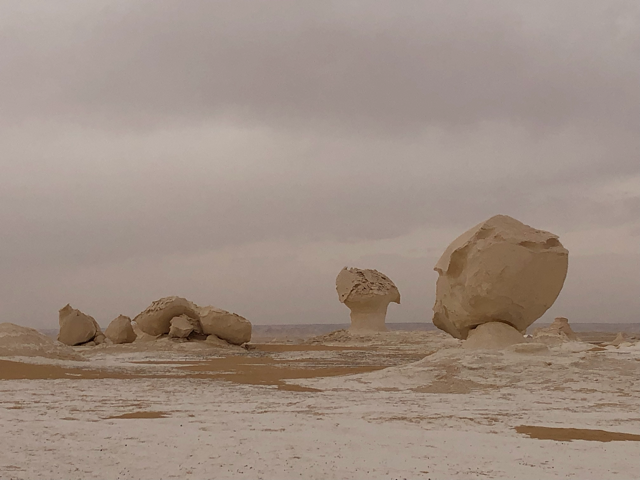



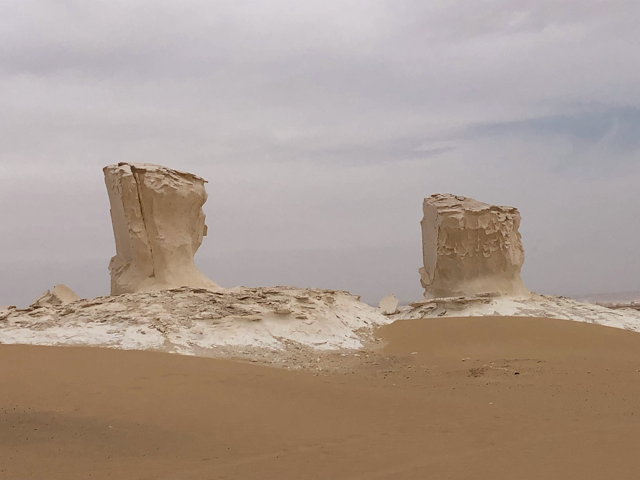

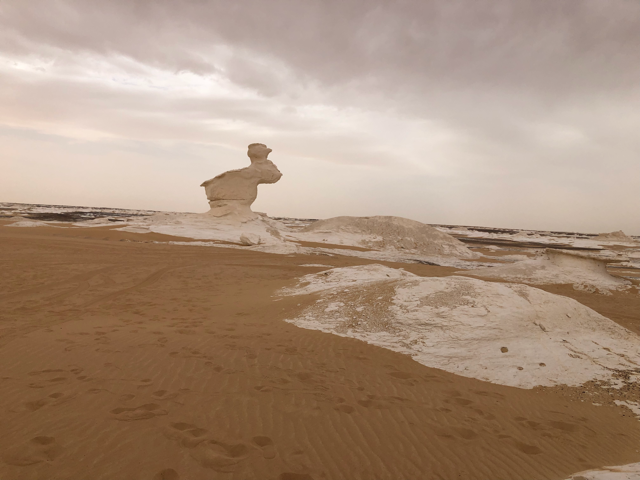



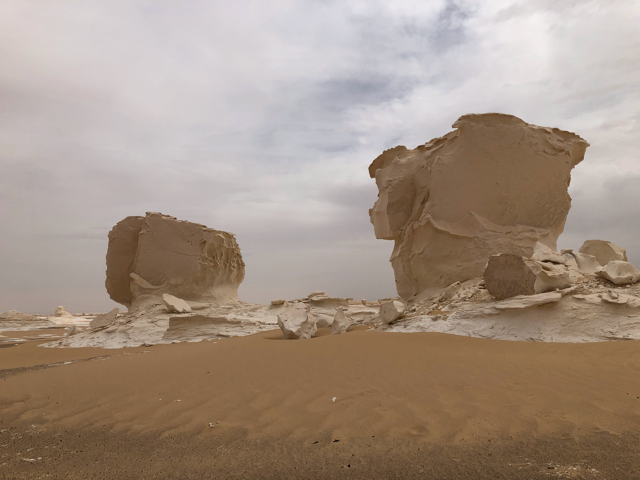





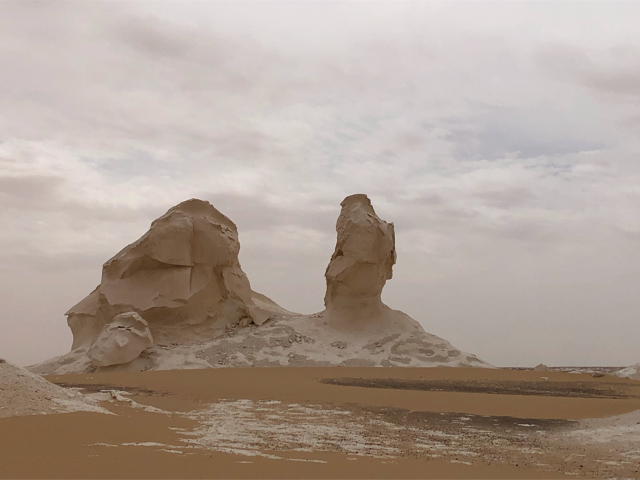



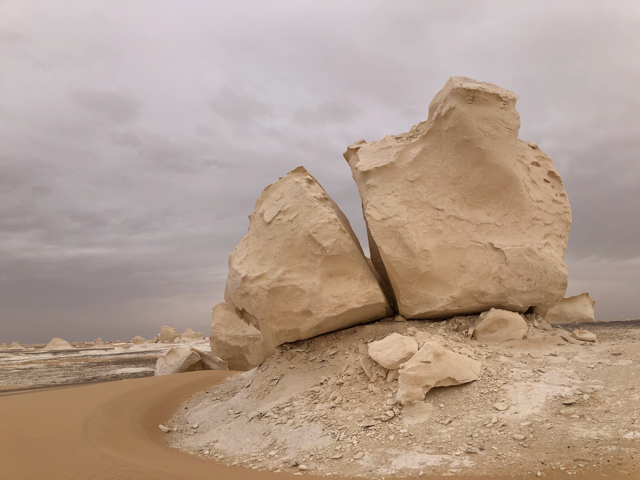















Comments